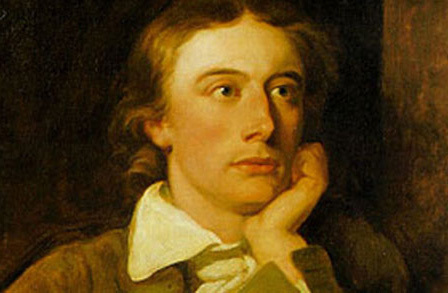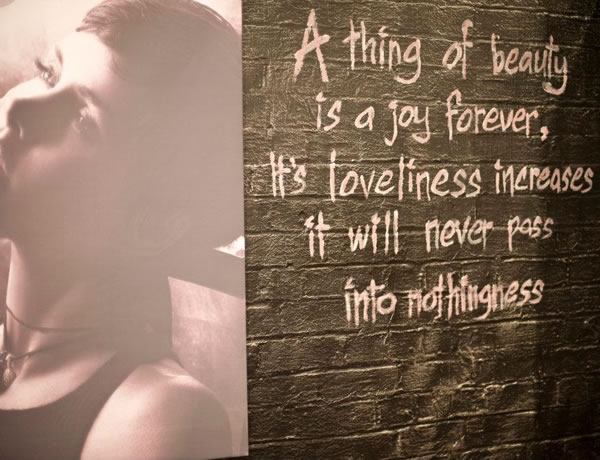Beaming Notes: Meg Merillies, John Keats (1795—1821) John Keats, wrote despairingly in a letter to Fanny Brawne, when he was consumptive “If I should die, I leave no immortal work behind.” A year later he died at only 25. Yet he ranks among now among the greatest poets in English Literature and became one of its mythic heroes. Obscure in life, “Keats in death became the defining symbol of doomed Romantic genius.” [Dana Gioia] Keats was orphaned at 14 and left at the mercy of his emotionally remote guardian. He maintained a close-knit relationship with his brothers and Sister Fanny as orphans who must depend on one another. His younger brother Tom died of tuberculosis and Keats nursed him to his deathbed. At this time, he contracted the disease that would kill him three years later.
Keats had qualified to be a surgeon, but never practiced. He was dedicated to poetry. He consciously strove for literary greatness but found mostly public indifference and critical hostility. What makes Keats‘s achievement particularly astonishing is the terrible brevity and intensity of his literary career.
“What made Keats’s creative process remarkable—as the poet himself understood—was his ability to shed his own personality temporarily and passionately identify with his subject. He called this act of imaginative self-annihilation “negative capability.”
Keats recognized it as a central quality of Shakespeare’s genius and cultivated it as a governing idea of his own artistic vision. (Keats so idealized Shakespeare that he always took a small portrait of the playwright with him on his travels.)
Keats declared that his sort of a poet “has no self—it is everything and nothing.” Religious beliefs and political loyalties had to be transcended to accommodate the speculative openness proper to a poet. He tried not to be timely but timeless.” [Dana Gioia]
Keats as a poet was sensual and used vivid, concrete imagery to portray the physical and the passionate. According to one nineteenth century critic, Keats’s mind was “constitutionally inapt for abstract thinking”. He went further to say that he “had no mind”. This is supported by Keats’s much-quoted outcry, “O for a life of Sensation rather than of thoughts!” (Letter, November 22, 1817)
Introduction to the Poem: Meg Merrilies
The delightful poem Meg Merrilies is included in one of Keats’s much famed and brilliant letters. It was written on the walking tour that he undertook through Scotland with his friend Charles Brown. He sent the poem to his younger sister Fanny. Charles Brown noticed that Keats was writing a letter and that it was not in regular prose. Keats said he was giving her a ballad on old Meg for her amusement, and considered it to be a trifle.
During the tour–this included the Kirkcudbrightshire coast, with its wild and soft scenery, its embosomed inlets and high craggy moors towering inland—they began to enjoy themselves to the full. Brown conjectured that this was Guy Mannering’s country, and fell talking to Keats about Meg Merrilies. Keats, who was acquainted with Scott’s work but had not read Guy Mannering, was much struck by what he heard.
Meg Merrilies
Old Meg she was a Gipsy,
And liv’d upon the Moors:
Her bed it was the brown heath turf
And her house was out of doors.
Her apples were swart blackberries,
Her currants pods o’ broom;
Her wine was dew of the wild white rose,
Her book a churchyard tomb.
Her Brothers were the craggy hills,
Her Sisters larchen trees–
Alone with her great family
She liv’d as she did please.
No breakfast had she many a morn,
No dinner many a noon,
And ‘stead of supper she would stare
Full hard against the Moon.
But every morn of woodbine fresh
She made her garlanding,
And every night the dark glen Yew
She wove, and she would sing.
And with her fingers old and brown
She plaited Mats o’ Rushes,
And gave them to the Cottagers
She met among the Bushes.
Old Meg was brave as Margaret Queen
And tall as Amazon:
An old red blanket cloak she wore;
A chip hat had she on.
God rest her aged bones somewhere–
She died full long a gone!
Keats had in this ‘trifle,’ using the ballad form for the first time, handled it with faultless tact, and though leaving out the tragic features of Scott’s creation, had been able to evoke of his own an instantaneous vision of her in vitally conceived spiritual relation with her surroundings. He copied the piece out in letters written in pauses of their walk both to his young sister and to his brother Tom. The letter to Fanny Keats is full of fun and nonsense, with a touch or two, which shows that he was fully sensitive to the charm of the Galloway coast scenery.
Summary of the poem Meg Merillies by John Keats :
Meg Merilles was a gypsy of the Moors, who slept on the “brown heath turf” of the wilderness, her house being “out of doors”.
She ate frugally, not apples but swart (dark coloured) blackberries, not currants but pods plucked off broom grass in the wild. And for wine, she had the “dew of the wild white rose”, a quaint beautiful expression.
She had nothing to read save the epitaphs on the Churchyard gravestones. Simply put, she led a simple vagrant life. She trusted to Nature, with no thought for what the morrow would bring. And so trusting, she seemed content with whatever frugal food she could gather, the dew of roses and blackberries. She drifted among the gravestones, quite unafraid of the sceptre of death.
Her brothers were none other than craggy hills and sisters, larchen trees. This was all the family she had and it was a great one, and among them she lived with enough space and liberty to do as she pleased.
Admittedly it was a hard life. There were times when she had to skip breakfast, at times dinner at noon and there were nights when she went without supper, sleepless ones when she would lay staring :
“Full hard against the Moon”
Yet, she remained undeterred in her daily routine which consisted of making garlands out of twining honeysuckle with fragrant red and yellow-white flowers, every morning.
Then every night she would weave the needle-like Yew leaves with her hands, singing all the while.
“But every morn of woodbine fresh
She made her garlanding,
And every night the dark glen Yew
She wove, and she would sing. “
Meg the gypsy was also of a generous nature and big hearted. With her old fingers, which had become brown, she plaited mats from rushes, (grass like plants with hollow cylindrical stems) and gave them away to the cottage dwellers who lived in the wilderness on the heath.
“And with her fingers old and brown
She plaited Mats o’ Rushes,
And gave them to the Cottagers
She met among the Bushes.”
In the final stanza we learn that old Meg was as brave and full of valour, as Queen Margaret. In stature she was as tall as an Amazon. Her dress was an old red blanket cloak and a chip hat. The poet prays that God rest her aged bones somewhere, as she died a long time ago.
“Old Meg was brave as Margaret Queen
And tall as Amazon:
An old red blanket cloak she wore;
A chip hat had she on.
God rest her aged bones somewhere–
She died full long agone!”
Analysis of the poem Meg Merillies by John Keats :
Theme:
Meg Merriles revolves around the familiar figure of folklore in the English Literature of the Romantic Period. The ballads and songs of this time were stories designed for light-hearted entertainment. The emphasis in Keats’s ballad is on the gypsy’s carefree and merry lifestyle, an enviable symbol for people entrapped in the system.
Poetic Devices:
The poem Meg Merrilies is a ballad also known as a folk ballad or traditional ballad. A ballad is simply a song, transmitted orally, which tells a story.
Keats’s ballad is dramatic, condensed and impersonal. It is in stanza form, called the ballad stanza—a quatrain in alternate four and three stress lines. The rhyme scheme used here is abab.
Meg the gypsy is introduced as a wondering nomad who lives out in the wilderness of the heath. Her character is sketched in a few stanzas with a sympathetic charm. The assonanance in the following line is lively and melodic:
“And her house was out of doors.”
A similar effect is produced by consonance in the line:
“Her wine was dew of the wild white rose,”
Wine is replaced here by the dew of the wild wet rose, contrasting city life with a fascinating rural ambiance.
The hills and trees of the heath are personified as Meg’s brothers and sisters. The natural surroundings are sketched in vivid images and bring home the fact of Meg’s total aloneness, yet signify too, that she was free and happy here, and lived life on her own terms.
Her poverty is amplified in a single stanza as we learn that often she was compelled to go hungry and on certain nights she slept without supper, contemplating on the Moon as surely, she couldn’t have slept.
Yet Meg was disciplined and generous and wove handcrafts from grasses and rushes to gift to the cottagers who were happy to receive them. An example of onomatopoeia is to be found in the following stanza:
“And with her fingers old and brown
She plaited Mats o’ Rushes,
And gave them to the Cottagers
She met among the Bushes”
In the last stanza there is the use of beautiful similes to present Meg as a dignified and powerful figure, self-actualised and loved by the rural folk for her statuesque personality.
“Old Meg was brave as Margaret Queen
And tall as Amazon:”
Some online learning platforms provide certifications, while others are designed to simply grow your skills in your personal and professional life. Including Masterclass and Coursera, here are our recommendations for the best online learning platforms you can sign up for today.
The 7 Best Online Learning Platforms of 2022
- Best Overall: Coursera
- Best for Niche Topics: Udemy
- Best for Creative Fields: Skillshare
- Best for Celebrity Lessons: MasterClass
- Best for STEM: EdX
- Best for Career Building: Udacity
- Best for Data Learning: Pluralsight














1 comment
Comments are closed.